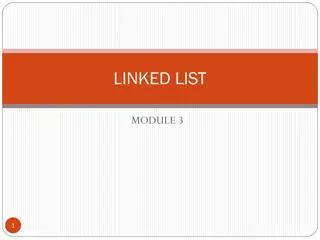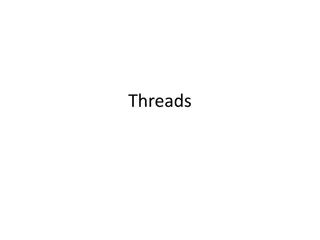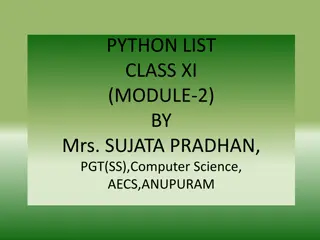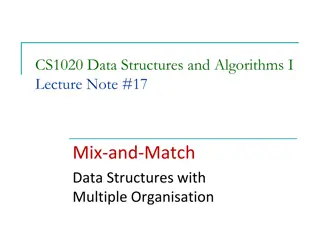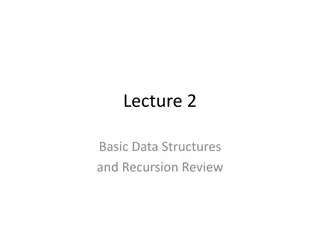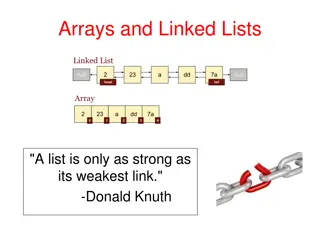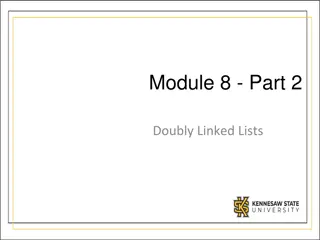Introduction to Linked Lists: An Overview of LinkedIntList
This lesson delves into Linked Lists by introducing the LinkedIntList and its implementation with a chain of linked nodes. Understanding the concept of LinkedIntList, its methods like add, get, indexOf, remove, size, and toString, as well as how it maintains references to its front, is crucial. Through a series of visual aids and explanations, learners will grasp the fundamentals of linked nodes and traversals, paving the way for a deeper comprehension of data structures.
Download Presentation

Please find below an Image/Link to download the presentation.
The content on the website is provided AS IS for your information and personal use only. It may not be sold, licensed, or shared on other websites without obtaining consent from the author. Download presentation by click this link. If you encounter any issues during the download, it is possible that the publisher has removed the file from their server.
E N D
Presentation Transcript
Lesson 7 Linked Lists Lesson 7 - Spring 2023 1
Linked Nodes So Far Small sequences of nodes connected together Using the ListNode class Traversals over these sequences with while loops data next data next node 121 122 Lesson 7 - Spring 2023 2
Introducing the LinkedIntList! New collection named LinkedIntList Lesson 7 - Spring 2023 3
Introducing the LinkedIntList! New collection named LinkedIntList Same kinds of methods as the ArrayIntList add, add, get, indexOf, remove, size, toString Lesson 7 - Spring 2023 4
Introducing the LinkedIntList! New collection named LinkedIntList Same kinds of methods as the ArrayIntList add, add, get, indexOf, remove, size, toString Implemented with chain of linked nodes Lesson 7 - Spring 2023 5
Introducing the LinkedIntList! New collection named LinkedIntList Same kinds of methods as the ArrayIntList add, add, get, indexOf, remove, size, toString Implemented with chain of linked nodes Keeps reference to its front as a field null is the end of the list If front is null, list is empty Lesson 7 - Spring 2023 6
Introducing the LinkedIntList! Implemented with chain of linked nodes Keeps reference to its front as a field null is the end of the list; if front is null, list is empty LinkedIntList front add(index) add(index, value) indexOf(value) remove(index) size() toString() Lesson 7 - Spring 2023 7
Introducing the LinkedIntList! Implemented with chain of linked nodes Keeps reference to its front as a field null is the end of the list; if front is null, list is empty LinkedIntList ListNode front data next add(index) add(index, value) indexOf(value) remove(index) size() toString() 16 Lesson 7 - Spring 2023 8
Introducing the LinkedIntList! Implemented with chain of linked nodes Keeps reference to its front as a field null is the end of the list; if front is null, list is empty LinkedIntList ListNode ListNode ListNode front data next data next data next add(index) add(index, value) indexOf(value) remove(index) size() toString() 16 -3 27 Lesson 7 - Spring 2023 9
printList Revisited Lesson 7 - Spring 2023 10
printList Revisited Client Code: Lesson 7 - Spring 2023 11
printList Revisited Client Code: Lesson 7 - Spring 2023 12
printList Revisited Client Code: Lesson 7 - Spring 2023 13
Client Code: front data next data next data next 16 -3 27 Lesson 7 - Spring 2023 14
Client Code: front data next data next data next 16 -3 27 Lesson 7 - Spring 2023 15
Client Code: front data next data next data next 16 -3 27 Lesson 7 - Spring 2023 16
Client Code: front data next data next data next 16 -3 27 Lesson 7 - Spring 2023 17
Client Code: front data next data next -3 27 Lesson 7 - Spring 2023 18
Client Code: front data next data next -3 27 Lesson 7 - Spring 2023 19
Client Code: front data next data next -3 27 Lesson 7 - Spring 2023 20
Client Code: front data next data next -3 27 Lesson 7 - Spring 2023 21
Client Code: front data next 27 Lesson 7 - Spring 2023 22
Client Code: front data next 27 Lesson 7 - Spring 2023 23
Client Code: front Lesson 7 - Spring 2023 24
Client Code: front Lesson 7 - Spring 2023 25
public void printList() { if (front == null) { System.out.println( [] ); } else { System.out.print( [ + front.data); ListNode curr = front.next; while (curr != null) { System.out.print( , + curr.data); curr = curr.next; } System.out.println( ] ); } } Client Code: front data next data next data next 16 -3 27 Lesson 7 - Spring 2023 27
public void printList() { if (front == null) { System.out.println( [] ); } else { System.out.print( [ + front.data); ListNode curr = front.next; while (curr != null) { System.out.print( , + curr.data); curr = curr.next; } System.out.println( ] ); } } Client Code: front data next data next data next 16 -3 27 Lesson 7 - Spring 2023 28
public void printList() { if (front == null) { System.out.println( [] ); } else { System.out.print( [ + front.data); ListNode curr = front.next; while (curr != null) { System.out.print( , + curr.data); curr = curr.next; } System.out.println( ] ); } } Client Code: curr front data next data next data next 16 -3 27 Lesson 7 - Spring 2023 29
public void printList() { if (front == null) { System.out.println( [] ); } else { System.out.print( [ + front.data); ListNode curr = front.next; while (curr != null) { System.out.print( , + curr.data); curr = curr.next; } System.out.println( ] ); } } Client Code: curr front data next data next data next 16 -3 27 Lesson 7 - Spring 2023 30
public void printList() { if (front == null) { System.out.println( [] ); } else { System.out.print( [ + front.data); ListNode curr = front.next; while (curr != null) { System.out.print( , + curr.data); curr = curr.next; } System.out.println( ] ); } } Client Code: curr front data next data next data next 16 -3 27 Lesson 7 - Spring 2023 31
public void printList() { if (front == null) { System.out.println( [] ); } else { System.out.print( [ + front.data); ListNode curr = front.next; while (curr != null) { System.out.print( , + curr.data); curr = curr.next; } System.out.println( ] ); } } Client Code: front data next data next data next 16 -3 27 Lesson 7 - Spring 2023 32
remove(int value) Visualization Lesson 7 - Spring 2023 33
Without Stopping One Early Client calls list.remove(-3) front data next data next data next data next 16 42 -3 27 Lesson 7 - Spring 2023 34
Without Stopping One Early Client calls list.remove(-3) front data next data next data next data next 16 42 -3 27 curr Lesson 7 - Spring 2023 35
Without Stopping One Early Client calls list.remove(-3) front data next data next data next data next 16 42 -3 27 curr Lesson 7 - Spring 2023 36
Without Stopping One Early Client calls list.remove(-3) front data next data next data next data next 16 42 -3 27 curr Lesson 7 - Spring 2023 37
Without Stopping One Early Client calls list.remove(-3) front data next data next data next data next 16 42 -3 27 curr Lesson 7 - Spring 2023 38
Without Stopping One Early Client calls list.remove(-3) This is the reference we need to change! front data next data next data next data next 16 42 -3 27 curr Lesson 7 - Spring 2023 39
Without Stopping One Early Client calls list.remove(-3) This is the reference we need to change! front data next data next data next data next 16 42 -3 27 curr Lesson 7 - Spring 2023 40
With Stopping One Early Client calls list.remove(-3) This is the reference we need to change! front data next data next data next data next 16 42 -3 27 Lesson 7 - Spring 2023 41
With Stopping One Early Client calls list.remove(-3) This is the reference we need to change! front data next data next data next data next 16 42 -3 27 curr Lesson 7 - Spring 2023 42
With Stopping One Early Client calls list.remove(-3) This is the reference we need to change! front data next data next data next data next 16 42 -3 27 curr Lesson 7 - Spring 2023 43
With Stopping One Early Client calls list.remove(-3) This is the reference we need to change! front data next data next data next data next 16 42 -3 27 curr Lesson 7 - Spring 2023 44
Changing a list There are only two ways to change a linked list: Change the value of front (modify the front of the list) Change the value of <node>.next (modify middle or end of list to point somewhere else) Implications: To add in the middle, need a reference to the previous node Front is often a special case 45


